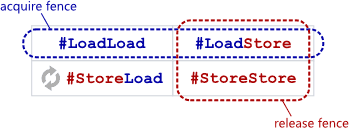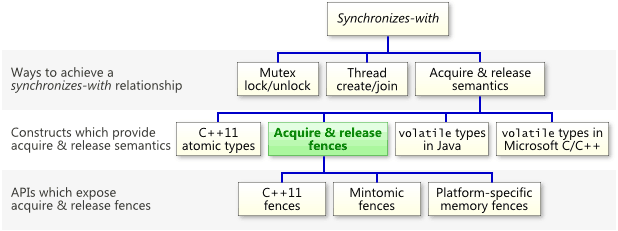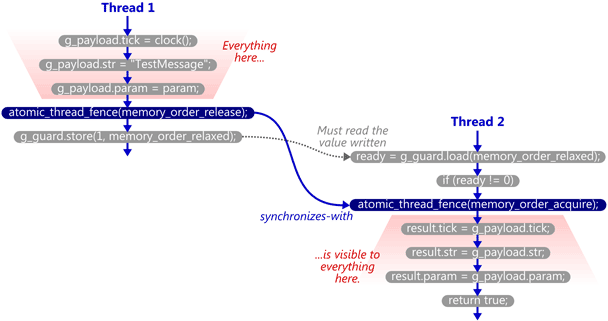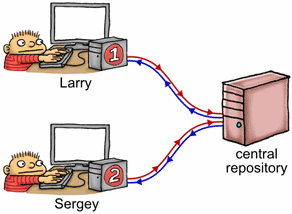Acquire and Release Fences
转载自: http://preshing.com/20130922/acquire-and-release-fences/
Acquire and release fences, in my opinion, are rather misunderstood on the web right now. That’s too bad, because the C++11 Standards Committee did a great job specifying the meaning of these memory fences. They enable robust algorithms which scale well across multiple cores, and map nicely onto today’s most common CPU architectures.
First things first: Acquire and release fences are considered low-level lock-free operations. If you stick with higher-level, sequentially consistent atomic types, such as volatile variables in Java 5+, or default atomics in C++11, you don’t need acquire and release fences. The tradeoff is that sequentially consistent types are slightly less scalable or performant for some algorithms.
On the other hand, if you’ve developed for multicore devices in the days before C++11, you might feel an affinity for acquire and release fences. Perhaps, like me, you remember struggling with the placement of some lwsync intrinsics while synchronizing threads on Xbox 360. What’s cool is that once you understand acquire and release fences, you actually see what we were trying to accomplish using those platform-specific fences all along.
Acquire and release fences, as you might imagine, are standalone memory fences, which means that they aren’t coupled with any particular memory operation. So, how do they work?
An acquire fence prevents the memory reordering of any read which precedes it in program order with any read or write which follows it in program order.
A release fence prevents the memory reordering of any read or write which precedes it in program order with any write which follows it in program order.
In other words, in terms of the barrier types explained here, an acquire fence serves as both a #LoadLoad + #LoadStore barrier, while a release fence functions as both a #LoadStore + #StoreStore barrier. That’s all they purport to do.

When programming in C++11, you can invoke them using the following functions:
#include <atomic>
std::atomic_thread_fence(std::memory_order_acquire);
std::atomic_thread_fence(std::memory_order_release);
In C11, they take this form:
#include <stdatomic.h>
atomic_thread_fence(memory_order_acquire);
atomic_thread_fence(memory_order_release);
And using Mintomic, a small, portable lock-free API:
#include <mintomic/mintomic.h>
mint_thread_fence_acquire();
mint_thread_fence_release();
On the SPARC-V9 architecture, an acquire fence can be implemented using the membar #LoadLoad | #LoadStore instruction, and an a release fence can be implemented as membar #LoadStore | #StoreStore. On other CPU architectures, the people who implement the above libaries must translate these operations into the next best thing – some CPU instruction which provides at least the required barrier types, and possibly more. On PowerPC, the next best thing is lwsync. On ARMv7, the next best thing is dmb. On Itanium, the next best thing is mf. And on x86/64, no CPU instruction is needed at all. As you might expect, acquire and release fences restrict reordering of neighboring operations at compile time as well.
They Can Establish Synchronizes-With Relationships
The most important thing to know about acquire and release fences is that they can establish a synchronizes-with relationship, which means that they prohibit memory reordering in a way that allows you to pass information reliably between threads. Keep in mind that, as the following chart illustrates, acquire and release fences are just one of many constructs which can establish a synchronizes-withrelationship.

As I’ve shown before, a relaxed atomic load immediately followed by an acquire fence will convert that load into a read-acquire. Similarly, a relaxed atomic store immediately preceded by a release fence will convert that store into a write-release. For example, if g_guard has type std::atomic<int>, then this line
g_guard.store(1, std::memory_order_release);
can be safely replaced with the following.
std::atomic_thread_fence(std::memory_order_release);
g_guard.store(1, std::memory_order_relaxed);
One precision: In the latter form, it is no longer the store which synchronizes-with anything. It is the fence itself. To see what I mean, let’s walk through a detailed example.
A Walkthrough Using Acquire and Release Fences
We’ll take the example from my previous post and modify it to use C++11’s standalone acquire and release fences. Here’s the SendTestMessage function. The atomic write is now relaxed, and a release fence has been placed immediately before it.
void SendTestMessage(void* param)
{
// Copy to shared memory using non-atomic stores.
g_payload.tick = clock();
g_payload.str = "TestMessage";
g_payload.param = param; // Release fence.
std::atomic_thread_fence(std::memory_order_release); // Perform an atomic write to indicate that the message is ready.
g_guard.store(1, std::memory_order_relaxed);
}
Here’s the TryReceiveMessage function. The atomic read has been relaxed, and an acquire fence has been placed slightly after it. In this case, the fence does not occur immediately after the read; we first check whether ready != 0, since that’s the only case where the fence is really needed.
bool TryReceiveMessage(Message& result)
{
// Perform an atomic read to check whether the message is ready.
int ready = g_guard.load(std::memory_order_relaxed); if (ready != 0)
{
// Acquire fence.
std::atomic_thread_fence(std::memory_order_acquire); // Yes. Copy from shared memory using non-atomic loads.
result.tick = g_payload.tick;
result.str = g_msg_str;
result.param = g_payload.param; return true;
} // No.
return false;
}
Now, if TryReceiveMessage happens to see the write which SendTestMessage performed on g_guard, then it will issue the acquire fence, and the synchronizes-with relationship is complete. Again, strictly speaking, it’s the fences which synchronize-with each other.

Let’s back up for a moment and consider this example in terms of the source control analogy I made a while back. Imagine shared memory as a central repository, with each thread having its own private copy of that repository. As each thread manipulates its private copy, modifications are constantly “leaking” to and from the central repository at unpredictable times. Acquire and release fences are used to enforce ordering among those leaks.

If we imagine Thread 1 as a programmer named Larry, and Thread 2 as a programmer named Sergey, what happens is the following:
- Larry performs a bunch of non-atomic stores to his private copy of
g_payload. - Larry issues a release fence. That means that all his previous memory operations will be committed to the repository – whenever that happens – before any store he performs next.
- Larry stores
1to his private copy ofg_guard. - At some random moment thereafter, Larry’s private copy of
g_guardleaks to the central repository, entirely on its own. Remember, once this happens, we’re guaranteed that Larry’s changes tog_payloadare in the central repository, too. - At some random moment thereafter, the updated value of
g_guardleaks from the central repository to Sergey’s private copy, entirely on its own. - Sergey checks his private copy of
g_guardand sees1. - Seeing that, Sergey issues an acquire fence. All the contents of Sergey’s private copy become at least as new as his previous load. This completes the synchronizes-with relationship.
- Sergey performs a bunch of non-atomic loads from his private copy of
g_payload. At this point, he is guaranteed to see the values that were written by Larry.
Note that the guard variable must “leak” from Larry’s private workspace over to Sergey’s all by itself. When you think about it, acquire and release fences are just a way to piggyback additional data on top of such leaks.
The C++11 Standard’s Got Our Back
The C++11 standard explicitly states that this example will work on any compliant implementation of the library and language. The promise is made in §29.8.2 of working draft N3337:
A release fence A synchronizes with an acquire fence B if there exist atomic operations X and Y, both operating on some atomic object M, such that A is sequenced before X, X modifies M, Y is sequenced before B, and Y reads the value written by X or a value written by any side effect in the hypothetical release sequence X would head if it were a release operation.
That’s a lot of letters. Let’s break it down. In the above example:
- Release fence A is the release fence issued in
SendTestMessage. - Atomic operation X is the relaxed atomic store performed in
SendTestMessage. - Atomic object M is the guard variable,
g_guard. - Atomic operation Y is the relaxed atomic load performed in
TryReceiveMessage. - Acquire fence B is the acquire fence issued in
TryReceiveMessage.
And finally, if the relaxed atomic load reads the value written by the relaxed atomic store, the C++11 standard says that the fences synchronize-with each other, just as I’ve shown.
I like C++11’s approach to portable memory fences. Other people have attempted to design portable memory fence APIs in the past, but in my opinion, few of them hit the sweet spot for lock-free programming like C++11, as far as standalone fences go. And while acquire and release fences may not translate directly into native CPU instructions, they’re close enough that you can still squeeze out as much performance as is currently possible from the vast majority of multicore devices. That’s why Mintomic, an open source library I released earlier this year, offers acquire and release fences – along with a consume and full memory fence – as its only memory ordering operations. Here’s the example from this post, rewritten using Mintomic.
In an upcoming post, I’ll highlight a couple of misconceptions about acquire & release fences which are currently floating around the web, and discuss some performance concerns. I’ll also talk a little bit more about their relationship with read-acquire and write-release operations, including some consequences of that relationship which tend to trip people up.
Acquire and Release Fences的更多相关文章
- Acquire and Release Semantics
An operation has acquire semantics if other processors will always see its effect before any subsequ ...
- Python用上锁和解锁 lock lock.acquire lock.release 模拟抢火车票
Python用上锁和解锁 lock lock.acquire lock.release 模拟抢火车票 import jsonimport timefrom multiprocessing impor ...
- Lock 深入理解acquire和release原理源码及lock独有特性acquireInterruptibly和tryAcquireNanos
https://blog.csdn.net/sophia__yu/article/details/84313234 Lock是一个接口,通常会用ReentrantLock(可重入锁)来实现这个接口. ...
- C11 memory_order
概念: 摘录自:http://preshing.com/20120913/acquire-and-release-semantics/ Acquire semantics is a property ...
- The JSR-133 Cookbook for Compiler Writers(an unofficial guide to implementing the new JMM)
The JSR-133 Cookbook for Compiler Writers by Doug Lea, with help from members of the JMM mailing lis ...
- Game Engine Architecture 5
[Game Engine Architecture 5] 1.Memory Ordering Semantics These mysterious and vexing problems can on ...
- An Introduction to Lock-Free Programming
Lock-free programming is a challenge, not just because of the complexity of the task itself, but bec ...
- android graphic(15)—fence
为何须要fence fence怎样使用 软件实现的opengl 硬件实现的opengl 上层使用canvas画图 上层使用opengl画图 下层合成 updateTexImage doComposeS ...
- 内存屏障 WriteBarrier 垃圾回收 屏障技术
https://baike.baidu.com/item/内存屏障 内存屏障,也称内存栅栏,内存栅障,屏障指令等, 是一类同步屏障指令,是CPU或编译器在对内存随机访问的操作中的一个同步点,使得此点之 ...
随机推荐
- 2-set 1823: [JSOI2010]满汉全席
这个题告诉我变量循环使用,一定要赋好初值!!!!!! 一定要赋好初值!!!!!!一定要赋好初值!!!!!!一定要赋好初值!!!!!! #include<iostream>#include& ...
- 每秒浮点运算次数flops
每秒浮点运算次数[编辑] 维基百科,自由的百科全书 跳到导航跳到搜索 此条目需要补充更多来源. (2018年2月28日)请协助添加多方面可靠来源以改善这篇条目,无法查证的内容可能会因为异议提出 ...
- jQuery多选和单选下拉框插件select.js
一.插件描述 可通过参数设置多选或者单选,多选返回数组结果,单选返回字符串,如图: 下载地址:https://pan.baidu.com/s/1JjVoK89_ueVVpfSlMDJwUQ 提取码 ...
- mysql中 where与having的区别
having子句与where有相似之处但也有区别,都是设定条件的语句.在查询过程中聚合语句(sum,min,max,avg,count)要比having子句优先执行.而where子句在查询过程中执行优 ...
- 齿轮 HYSBZ - 4602 (DFS实现)
齿轮 HYSBZ - 4602 题意:很好理解就不啰嗦了. 致谢:感谢队友小明. 题解:嗯,一开始想到的是并查集,后来,就先看了另一道题,xj写dfs和暴力,就卡死了.于是来补这题了,前向星建图 题解 ...
- P3119 [USACO15JAN]草鉴定
约翰有n块草场,编号1到n,这些草场由若干条单行道相连.奶牛贝西是美味牧草的鉴赏家,她想到达尽可能多的草场去品尝牧草. 贝西总是从1号草场出发,最后回到1号草场.她想经过尽可能多的草场,贝西在通一个草 ...
- kvm 学习(二)镜像
Linux下 如何通过命令行使用现有的镜像创建.启动kvm虚拟机 这里假定已经创建好了相应的镜像: eg:我这里制作的镜像名称为zu1-centos7.img # ls zu1-centos7.img ...
- IdentityServer4入门三:授权模式
在入门一.入门二我们实现了一个完整的API保护的过程.需要保护的API只需在其Controler上应用[Authorize]特性,来显式指定受保护的资源.而我们实现的这个例子,所应用的模式叫“Clie ...
- python中的with的用法,上下文管理器
with是从Python2.5引入的一个新的语法,它是一种上下文管理协议,目的在于从流程图中把 try,except 和finally 关键字和 资源分配释放相关代码统统去掉,简化try….excep ...
- 接口操作XML
接口操作XML 以下代码旨在 脱离TXMLDocument 操作 xml. unit Unit3; interface uses Windows, Messages, SysUtils, Varian ...
